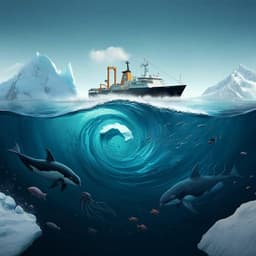Introduction
Marine silicate alteration, encompassing marine silicate weathering and reverse weathering, significantly influences global carbon and cation cycles. Marine silicate weathering consumes CO₂ and increases alkalinity by dissolving reactive silicates, acting as a natural CO₂ sink. Conversely, reverse weathering decreases alkalinity and releases CO₂ through the formation of cation-rich marine clays from secondary minerals and biogenic opal. Traditionally, reverse weathering was considered a slow process, but recent research indicates faster rates, particularly in tropical regions with abundant terrestrial mineral supply. This study investigates the speed of authigenic clay formation in response to extreme weather events, focusing on the impact of coastal El Niño events on the Peruvian margin. Stable silicon (Si) isotopes (δ³⁰Si) and germanium (Ge) are employed as tracers of silicate mineral reactions, complemented by analyses of Al concentrations. Understanding the dynamics of these processes is crucial for comprehending their impact on marine alkalinity and CO₂ cycling, particularly given the increasing frequency of extreme weather events due to climate change.
Literature Review
Previous research has established the importance of marine silicate alteration in the global biogeochemical cycles. Studies have shown that while marine silicate weathering acts as a CO2 sink, reverse weathering, through the formation of authigenic clays, can release CO2. The rate of reverse weathering has been a subject of ongoing investigation, with earlier studies suggesting slow kinetics over millennia. However, more recent work has demonstrated that authigenic clay formation can occur much faster, within months to years, especially in tropical areas with high terrestrial mineral influx. Stable Si isotopes (δ³⁰Si) and Ge/Si ratios have been recognized as effective tracers for understanding silicate mineral reactions, including the coupled processes of dissolution and precipitation. The behavior of Ge, a chemical analog of Si, further aids in disentangling these complex reactions in marine sediments. Existing literature suggests that the formation of authigenic clays on the Peruvian margin is often limited by the availability of terrigenous material, specifically aluminum.
Methodology
Sediment cores and pore fluids were collected from the Peruvian margin in 2013, 2008, and 2017 using a multiple corer (MUC). Benthic chambers were deployed to study in-situ processes. Samples were analyzed for major elements (Si, Al, K) using ICP-OES, Ge and Al concentrations in pore fluids were determined via high-resolution ICP-SF-MS. Silicon isotope ratios (δ³⁰Si) in pore fluids were measured using MC-ICP-MS following single-column chemistry. In-situ Si isotope ratios in sediments were determined using femtosecond laser ablation (fsLA)-MC-ICPMS. Mineral composition was analyzed using X-ray diffraction (XRD) and electron microprobe (EMP). A 1-D reaction-transport model was developed to simulate Si turnover in the sediments, considering factors such as diffusion, bioturbation, sediment burial, and biogeochemical reactions. The model incorporates five solid species and four dissolved species to calculate isotopic composition and Ge/Si ratios in pore fluids.
Key Findings
The 2017 sampling campaign, following a coastal El Niño event, revealed significantly elevated δ³⁰Si values (+3.72‰) in shelf pore fluids compared to previous years (+1.33‰ in 2013 and +1.21‰ in 2008). These elevated values, along with increased Ge/Si ratios and Al concentrations in the uppermost sediments, strongly suggest extensive authigenic clay formation. Electron microprobe analyses confirmed the presence of authigenic clays enriched in K, Fe, Mg, and Al. The extreme rainfall associated with the coastal El Niño event transported large amounts of reactive terrigenous silicates to the seafloor, overcoming the usual limitation of terrigenous material supply for authigenic clay formation. A reaction-transport model indicated significantly higher authigenic clay precipitation rates in 2017 (291 µmol cm⁻² yr⁻¹) compared to 2013 (13 µmol cm⁻² yr⁻¹). The data shows a clear deviation from the typical mixing line between seawater and pore fluids influenced by diatom and feldspar dissolution, indicating the significant influence of authigenic clay formation in the 2017 event.
Discussion
The findings directly address the research question concerning the rapidity of marine silicate alteration in response to extreme weather events. The dramatic increase in authigenic clay formation following the 2017 coastal El Niño highlights the close coupling between terrestrial erosion and marine sedimentary processes. The observed rapid response challenges the traditional view of reverse weathering as a slow process, demonstrating its potential to significantly impact marine CO₂ cycling on human timescales (weeks to months). The study emphasizes the importance of considering the dynamic nature of these processes when assessing the global carbon cycle and its response to climate change. The model suggests that under the conditions observed, reverse weathering rates exceed terrestrial mineral weathering rates. This highlights the significant role of coupled weathering processes in regions receiving diverse mineral inputs from the continents.
Conclusion
This study demonstrates the surprisingly rapid response of marine silicate alteration to extreme precipitation events, showing that authigenic clay formation can occur on timescales of weeks to months, far faster than previously assumed. The increased influx of reactive terrigenous minerals due to coastal El Niño events directly accelerated reverse weathering, profoundly impacting marine alkalinity and CO2 cycling. This underscores the need to integrate the effects of extreme climate events into assessments of global biogeochemical cycles and further research should investigate the global extent of coupled weathering and its sensitivity to future climate change scenarios.
Limitations
The study focuses on a specific location (Peruvian margin) and a single extreme event. The generalizability of the findings to other regions and the long-term implications of repeated extreme events require further investigation. The model used simplifies complex biogeochemical processes, and while it captures the main trends, finer-scale variations and other contributing factors may exist.
Related Publications
Explore these studies to deepen your understanding of the subject.







